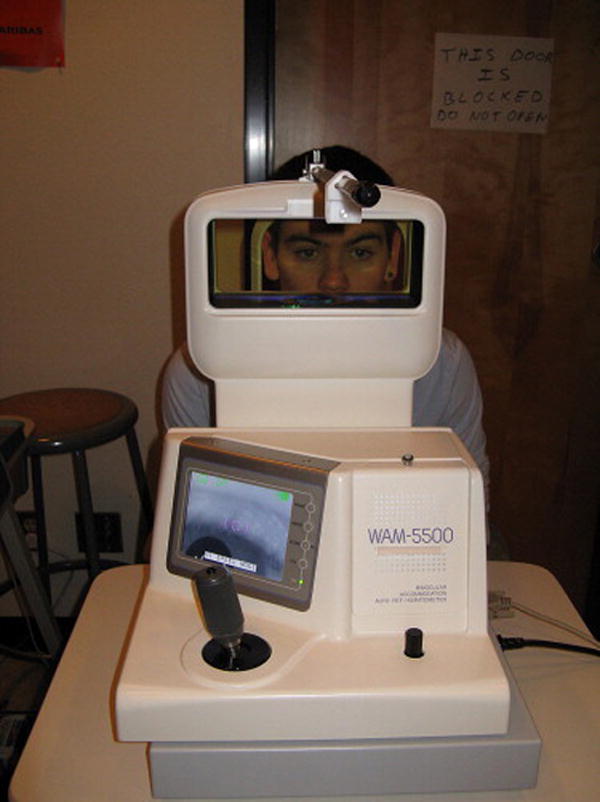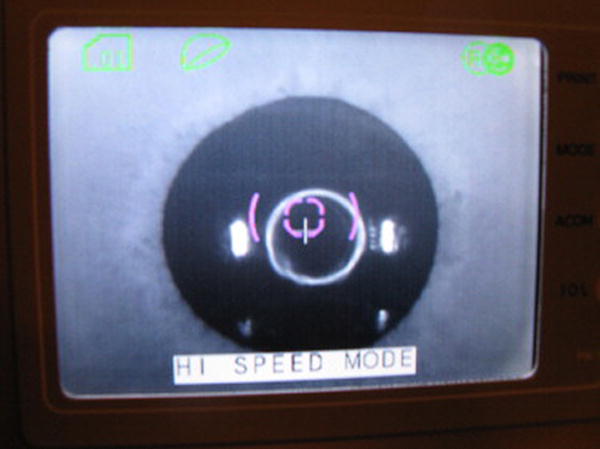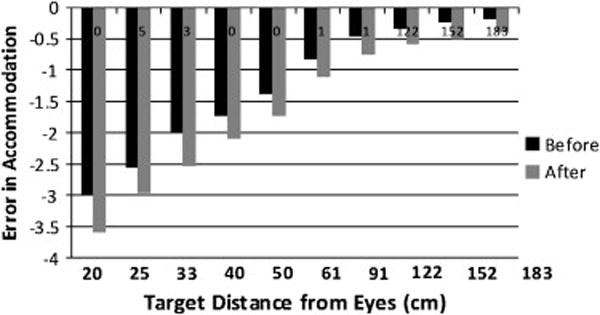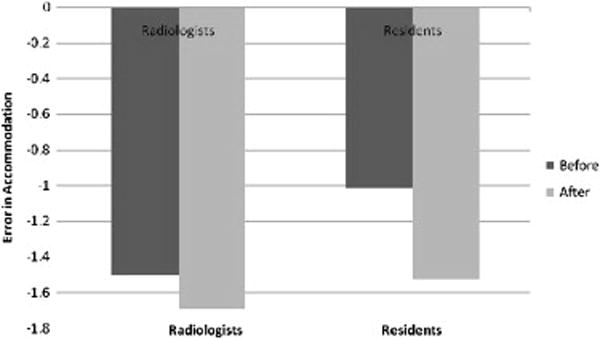Abstract
Rationale and Objectives
We hypothesize that the current practice of radiology produces oculomotor fatigue that reduces diagnostic accuracy.
Materials and Methods
Testing this hypothesis requires an ability to measure eyestrain. We develop this capability by measuring visual accommodation of radiologists before and after diagnostic viewing work using an autorefractor that is capable of make multiple measurements of accommodation per second. Three radiologists and three residents focused on a simple target placed at near to far distances while accommodation was measured. The target distances varied from 20 cm to 183 cm from the eye. The data were collected prior to and after a day of digital diagnostic viewing.
Results
Results indicate that accommodation at near distances is significantly worse overall compared to far distances and is significantly worse after a day of digital reading at all distances.
Conclusion
Because diagnostic image interpretation is performed at near viewing distances, this inability to maintain focus on the image could impact diagnostic accuracy. As expected, younger residents had better accommodative accuracy than older radiologists.
Keywords: visual accommodation, target distance, radiologists
Introduction
Routing imaging studies to radiologists over digital networks increases access to sub-specialists and previous imaging studies. Reports are transported more rapidly and productivity is increased. However, many digital displays still offer less contrast than film and reduced spatial resolution, information used by the visual system to regulate image focus, single vision, and direction of gaze. Digital display could increase the strain on radiologists' eyes and reduce their performance. Our overall hypothesis is that radiology displays produce oculomotor fatigue that reduces diagnostic accuracy. A first step is to discover whether measureable eye strain results from reading radiology displays. In this initial study, we measure visual accommodation of radiologists before and after diagnostic viewing work.
Close work of any kind for hours on end can overwork the eyes, resulting in eyestrain (known clinically as asthenopia) (1-2). With non-medical computer displays, just four hours is sufficient to produce asthenopia (3) and there is some evidence that prolonged computer use may even induce myopia in many computer users (4-5). Oculomotor fatigue caused by close work with digital displays may add to the effects of extended workdays and aging eyes (6). Although eyestrain has not been studied in radiology, we do have preliminary data showing that radiologists report increasingly severe symptoms of eyestrain, including blurred vision and difficulty focusing (see Table 1), as they read more imaging studies (7). The symptoms were assessed for film viewing only, digital viewing only, and a combination of film and digital viewing. Symptoms were worst when radiologists switched between film and digital viewing throughout the day and were less when only film examinations were read (7).
Table 1.
Correlation between subjective fatigue, how long and how many cases radiologists read.
| Variable | “How long” correlation | “How many” correlation |
|---|---|---|
| Headache | R = 0.24, p = 0.09 | R = 0.43, p < .002 |
| Eyestrain | R = 0.43, p < .002 | R = 0.48, p < .001 |
| Difficulty focus | R = 0.38, p < .005 | R = 0.45, p < .001 |
| Blurred vision | R = 0.34, p < .02 | R = 0.42, p < .002 |
Eyestrain is caused by additional work that oculomotor systems must perform to maintain accommodation (focus), convergence (single vision), and gaze (directing the fovea). In this study we chose to measure accommodation as the inability to focus is often the first symptom of visual fatigue and it has been validated by others as a reliable measure of visual fatigue (6, 8-11). Double vision can occur but is less common and is difficult to measure objectively. In future studies we will be measuring gaze accuracy using eye-tracking equipment while observers search clinical images. Accommodative asthenopia is caused by strain of the ciliary muscles, whereas muscular asthenopia is caused by strain of the external ocular muscles. Both lead to physical symptoms: blurred or double vision, headaches, and pain in and around the eyes. Therefore, there is not a single potential cause of symptoms, and the presence of a symptom may indicate any of several different malfunctions of oculomotor control. Different work environments stress the eyes in different ways. (12) For example inertial forces acting on the eyes of a pilot are not present in the radiology reading room. Likewise, perceptual activities, such as cine display of a computed tomography (CT) dataset under viewer control, are not found in other work environments.
Our long-term goal is to determine whether increased visual fatigue that results from long hours of near computer viewing impacts diagnostic accuracy. The eyes have a default accommodation distance that is called the resting point of accommodation (RPA). This is the distance at which the eyes focus when there is nothing to focus on. In total darkness the eyes are set to focus at a particular distance, so that if the lights were turned on, an object at that distance would be in clear focus. The RPA averages 30 inches for younger people and gets farther away with age. Thus, near viewing is typically regarded as distances closer than the RPA. In general it is recommended that computer users sit 20 – 40 inches from a display so computer use is clearly a near viewing task (13). The goal of the present investigation is to examine visual fatigue/stress by measuring visual accommodation to find out whether there are changes in accommodation as a function of near work in radiology.
Materials & Methods
The lens of the eye is used to alter the refractive index of light entering the eye to focus images on the retina. The lens is covered by an elastic capsule whose function is to mold its shape, varying its flatness and therefore its optical power. This variation in optical power is called accommodation, and it occurs as the eye focuses on a close object. We measure accommodation using a WAM-5500 Auto Refkeratometer from Grand Seiko, which collects refractive measurements and pupil diameter measurements. The WAM-5500 records accommodation and hence any shifts or errors in accommodation as a function of target distance. The amount of error is a function of a number of variables, including the target distance, the visual status of the observer, and whether their vision is corrected.
To record accommodation, the subject is seated in front of the device with the chin in a chinrest and their forehead against a headrest to maintain a stable position (see Figure 1). The device obtains an image of the eye and the operator aligns the eye with a reticle mark using a joystick (see Figure 2). Once the eye is focused properly, measurement begins automatically with the press of a button. We selected a series of near and far targets (a large asterisk) for the subject to fixate while measurements are recorded. The target starts on a rod attached to the device for near-viewing targets at 20, 25, 33, 40 and 50 cm from the eye (these correspond to 5, 4, 3, 2.5 and 2 diopters respectively). We then attach the target to a stand that we can move to farther distances to measure far-viewing targets. A black curtain is placed behind the final target distance to eliminate any distractions for the subject. The targets for far-viewing are set to 61, 91, 122, 152 and 183 cm from the subject's eye. The targets are kept at the same height and orthogonal position relative to the subject's eye throughout the testing procedure.
Figure 1.

The WAM-5500 accommodation device. The subject (seated in back) looks through a screen at a target (not shown). The screen at the bottom left shows the subject's eye. The joystick is used to center the eye for obtaining measurements.
Figure 2.

The view of the subject's eye during accommodation recording that the experimenter sees.
The study was approved by the local IRB. Subjects were three radiologists (ages 47, 52, 68) and three radiology residents (ages 28, 28, 30). All three radiologists wore glasses (2 wore bifocals, 1 wore reading glasses only) and one of the residents wore glasses (near sighted). Observers wore their glasses/contacts during the recordings if they use them during radiographic image viewing as we wanted to record accommodation in conditions as close as possible to clinical reading. We collected accommodation data at two points in time for each subject - once in the morning (prior to any diagnostic reading activity) and once in the late afternoon (after a day of diagnostic reading). On average the participants had been reading for 5.73 hours (sd = 1.24) at the time of the late afternoon session and had been reading cases from all modalities. The number of cases varied by modality ranging from 13 with CT to 54 with CR (chest and bone mostly). Each session took approximately 30 minutes to complete.
Results
The main results are summarized in Figure 3, showing the average error in accommodation across all observers. The near target distances (20 cm) start on the left and get progressively farther away to the right (ending at 183 cm). The y-axis shows the ability of the subject to accommodate where the “0”-line represents good accommodation. It can be seen that for all distances the accommodation measures for after a day of near distance reading are worse (do not accommodate as well) than for the before reading measurements.
Figure 3.

Error in accommodation measures at near and far distances for four radiologists before and after a day of near viewing reading from computer displays.
An Analysis of Variance (ANOVA) was used to examine the data using the accommodation measurements as the dependent variable and target distance, time of day and radiologist vs resident as independent variables. There was a statistically significant difference (F = 1188.36, p < 0.0001) in the data as a function of target distance, as a function of time of day (F = 316.10, p < 0.0001), and radiologists vs residents (F = 271.47, p < 0.0001). Figure 3 shows the changes in accommodation as a function of distance acquired before a day of reading (black bars) and after a day of reading (Gray bars). The target distances are plotted on the x-axis with the target closest to the eye (20 cm) on the left and the target farthest from the eye (183 cm) on the right. The zero point on the y-axis represents perfect accommodation (no visual strain). As the eye has more difficulty accommodating, hence focusing, the accommodation measures extend further away from zero (i.e., larger numbers indicate poorer accommodation). Overall, the observers were less able to accommodate to the nearest targets and progressively improved in their ability as the target distance increased (F = 1188.36, p < 0.0001). As Figure 3 shows, accommodation was worse at all distances after a day of reading as compared to before a day of reading (F = 316.10, p < 0.0001). Figure 4 compares the before and after accommodation measurements (across all target distances) for the radiologists versus the residents. Although both groups showed significantly poorer ability to accommodate after a day of reading, the radiologists overall had poorer accommodation at both points in time compared to the residents (F = 271.47, p < 0.0001).
Figure 4.

Error in accommodation measures for radiologists and residents before and after a day of near viewing reading from computer displays.
Discussion
The ability to accommodate is reduced after a day of radiology near work. As the target progressively gets closer to the readers' eyes (i.e., as it simulates near work reading) the ability to accommodate gets progressively worse as well (left side of Figure 3). As the target gets farther away, the ability to accommodate improves. It is interesting to note that the ability to accommodate to the far targets is also worse after a day of near viewing.
It was not surprising to find that the older radiologists had poorer accommodation compared to the residents. Of course, our ability to accommodate decreases with age. (6) It was interesting to see however, that the drop in accommodative ability was larger for the residents than the radiologists (change of 0.508 vs 0.190). There are several possible explanations that need to be studied. Perhaps residents are spending more time searching images during the day than the radiologists, resulting in more fatigue. In fact, studies have shown that experienced radiologists spend less time inspecting images than do those with less experience. (14-16)
Reading diagnostic images from digital displays fatigues the accommodative response in radiologists. The degradation seems to be more severe for near vision, just as one would expect. It is also the main problem – reading radiology imaging studies is near work, requiring good accommodation. If the muscles required to accommodate at near distances become fatigued as the day progresses, the radiologist will have a harder time focusing on the display properly. With difficulty focusing, it may be more difficult to detect abnormalities reducing accuracy or requiring more reading time.
Acknowledgments
This paper was supported in part by grants R01EB004987 from the NIH (NIBIB).
Footnotes
Publisher's Disclaimer: This is a PDF file of an unedited manuscript that has been accepted for publication. As a service to our customers we are providing this early version of the manuscript. The manuscript will undergo copyediting, typesetting, and review of the resulting proof before it is published in its final citable form. Please note that during the production process errors may be discovered which could affect the content, and all legal disclaimers that apply to the journal pertain.
References
- 1.Ebenholtz SM. Oculomotor systems and perception. New York, NY: Cambridge University Press; 2001. [Google Scholar]
- 2.MacKenzie W. On asthenopia or weak-sightedness. Edinburgh J Med & Surg. 1843;60:73–103. [PMC free article] [PubMed] [Google Scholar]
- 3.Sanchez-Roman FR, Perez-Lucio C, Juarez-Ruiz C, Velez-Zamora NM, Jimenez-Villarruel M. Risk factors for asthenopia among computer terminal operators. Salud Publica de Mexico. 1996;38:189–196. [PubMed] [Google Scholar]
- 4.Komiushina TA. Physiological mechanisms of the etiology of visual fatigue during work involving visual stress. Vestnik Oftalmologii. 2000;116:33–36. [PubMed] [Google Scholar]
- 5.Mutti DO, Zadnik K. Is computer use a risk factor for myopia? J Am Optometric Assn. 1996;67:521–53. [PubMed] [Google Scholar]
- 6.Heron G, Charman WN, Gray LS. Accommodation responses and ageing. Invest Ophthal Visual Science. 1999;40:2872–2883. [PubMed] [Google Scholar]
- 7.Krupinski EA, Kallergi M. Choosing a radiology workstation: technical and clinical considerations. Radiol. 2007;242:671–682. doi: 10.1148/radiol.2423051403. [DOI] [PubMed] [Google Scholar]
- 8.Sterner B, Gellerstedt M, Sjostrom A. Accommodation and the relationship to subjective symptoms with near work for young school children. Ophthal Physiol Opt. 2006;26:148–155. doi: 10.1111/j.1475-1313.2006.00364.x. [DOI] [PubMed] [Google Scholar]
- 9.Iwasaki T, Tawara A, Miyake N. Reduction of asthenopia related to accommodative relaxation by means of far point stimuli. Acta Ophthal Scand. 2005;83:81–88. doi: 10.1111/j.1600-0420.2005.00352.x. [DOI] [PubMed] [Google Scholar]
- 10.Pigion RG, Miller RJ. Fatigue of accommodation: changes in accommodation after visual work. Am J Optom Phys Opt. 62:853–863. [PubMed] [Google Scholar]
- 11.Murata A, Uetake A, Otsuka M, Takaswaw Y. Proposal of an index to evaluate visual fatigue induced during visual display terminal tasks. Intl J Hum Comput Int. 2001;13:305–321. [Google Scholar]
- 12.National Transportation Safety Board. Evaluation of US Department of Transportation Efforts in the 1990s to Address Operator Fatigue. Safety Report NTSB/SR-99/01, PB99-917002; Notation 7155, May 1999 [Google Scholar]
- 13.Occupational Safety & Health Administration. [January 30, 2009]; http://www.osha.gov/SLTC/etools/computerworkstations/components_monitors.html#Viewing%20Distance. Last.
- 14.Krupinski EA. Visual scanning patterns of radiologists searching mammograms. Acad Radiol. 1996;3:137–144. doi: 10.1016/s1076-6332(05)80381-2. [DOI] [PubMed] [Google Scholar]
- 15.Krupinski EA, Tillack AA, Richter L, et al. Eye-movement study and human performance using telepathology virtual slides: implications for medical education and differences with experience. Human Path. 2006;37:1543–56. doi: 10.1016/j.humpath.2006.08.024. [DOI] [PubMed] [Google Scholar]
- 16.Mello-Thoms C, Ganott M, Sumkin J, Hakim C, et al. Different search patterns and similar decision outcomes: how can experts agree in the decisions they make when reading digital mammograms? In: Krupinski EA, editor. International Workshop on Digital Mammography 2008, Lecture Notes on Computer Science 5116. Berlin, Germany: Springer-Verlag; 2008. pp. 212–219. [Google Scholar]


